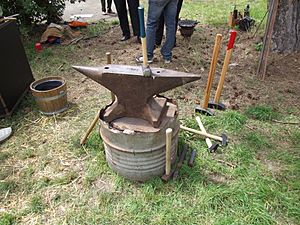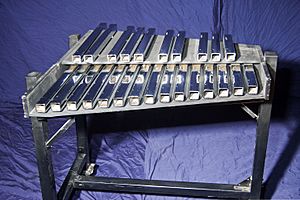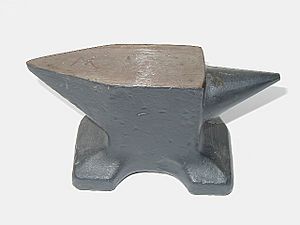Anvil facts for kids
An anvil is a super hard piece of metal. It's like a special workbench used by a blacksmith to shape hot iron or steel. When a blacksmith needs to bend or flatten metal, they hit it with a hammer on the anvil. Blacksmiths can make many things, like new shoes for horses!
Anvils have been around for a very long time. People used them in the Bronze Age, and even in Ancient Greece and Ancient Egypt. They are still used today, but not as much as they were 100 years ago. Back then, there were many more horses that needed shoes!
Anvils are very heavy. They come in different sizes. For example, John Bunyan, a writer from the 17th century, was a tinker. He fixed pots and pans. He carried a small, wedge-shaped anvil on his back. He could stick it into the ground when he needed to make a repair. His anvil is now in a museum in Bedford.
Contents
What is an Anvil Made Of?
An anvil has several important parts. The main flat part where you hit the metal is called the face. It's usually made of very hard steel. The face needs to be flat and smooth. If it has marks, those marks can transfer to the metal you are working on. Also, sharp edges on the face can cut into the metal.
The face is made hard so it doesn't get damaged by hammer blows. A hard face also helps the hammer blows work better. You should never hit the anvil face with other hard tools or metal, as this can chip or damage it.
The horn is the pointy, cone-shaped part of the anvil. It's used to bend metal into round shapes. The horn is usually not as hard as the face. Some anvils, especially older European ones, have two horns. One might be round and the other square.
The step is the area between the horn and the face. This part is softer. It's sometimes used for cutting, so the main hard face doesn't get damaged. However, some blacksmiths prefer not to cut on the step because it can still damage the anvil over time.
The hardie hole is a square hole in the anvil. Special tools called Hardy tools fit into this hole. These tools can help with shaping, cutting, or punching holes in metal.
The pritchel hole is a small, round hole. Most modern anvils have one, and some have more. It's mostly used for punching holes in metal. Sometimes, blacksmiths put a second tool in this hole for more flexibility.
Where Do You Put an Anvil?

An anvils needs a strong base. This base should be made of something that can handle impacts and won't catch fire. It's very important to fasten the anvil tightly to its base. If it's loose, it can be dangerous and won't work well. Blacksmiths use things like spikes, chains, or bolts to hold the anvil in place.
The anvil is usually placed close to the forge (where the metal is heated). This helps keep the metal hot while the blacksmith works on it.
Traditionally, the most common base was a large log or timber. It was often buried partly in the ground to make the anvil very stable. Later, cast iron bases became popular. These added more weight, making the anvil even more stable. Today, many anvils are placed on bases made from steel, or even blocks of wood bolted together.
Anvils in Music

Sometimes, anvils are used as percussion instruments in music. They make a very loud, ringing sound when hit. Musicians often use a metal bar on a sound-box instead of a real anvil. This is much easier to carry around!
Many famous composers have used the sound of an anvil in their music:
- Giuseppe Verdi wrote the famous Anvil Chorus in his opera Il Trovatore.
- Richard Wagner asked for 18 anvils in his opera Das Rheingold.
- Johann Strauss II wrote an Anvil Polka.
- Edgard Varèse used an anvil in Ionisation.
- William Walton included an anvil in Belshazzar’s Feast.
- There's also an anvil in the orchestra for Howard Shore's music in The Lord of the Rings movies.
Related pages
Images for kids
-
A blacksmith working iron with a hammer and anvil
-
A blacksmith working with a sledgehammer, assistant (striker) and Lokomo anvil in Finland
-
An anvil at the medieval construction site of Guédelon in Treigny, France.
-
Crab-eating macaque using a stone to crush food against rock
-
Mime at the anvil by Arthur Rackham
See also
 In Spanish: Yunque para niños
In Spanish: Yunque para niños














